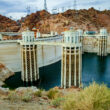Nestled just 30 miles southeast of Las Vegas, the Hoover Dam stands as a monumental testament to human ingenuity and resilience. A visit to this iconic structure offers not only a glimpse into a marvel of modern engineering but also a dive into the rich history of the American Southwest. Whether you’re a history buff, an engineering enthusiast, or simply seeking a break from the glitz of the Vegas Strip, a day trip to the Hoover Dam is an unforgettable experience. This article explores the journey from Las Vegas, the dam’s historical significance, and the fascinating stories of the surrounding areas.
Getting to the Hoover Dam from Las Vegas
The Hoover Dam is an easy 45-minute drive from Las Vegas, making it a perfect day trip. Most visitors opt to rent a car, which offers flexibility to explore at your own pace. Take US-93 South from Las Vegas, and you’ll cross into Arizona, where the dam straddles the state line along the Colorado River. The drive is scenic, with the desert landscape giving way to the dramatic Black Canyon, where the dam is situated. Alternatively, numerous guided tours depart from Las Vegas, offering transportation and expert commentary. These tours often include stops at nearby attractions like Lake Mead or the Mike O’Callaghan-Pat Tillman Memorial Bridge, which provides a stunning aerial view of the dam.
For those looking to save time, shuttle services and even helicopter tours are available, offering a unique perspective of the dam’s scale against the rugged terrain. Whichever mode of transport you choose, plan for at least half a day to fully appreciate the site, with options to extend your visit to nearby areas.
A Brief History of the Hoover Dam
The Hoover Dam, originally called the Boulder Dam, was constructed between 1931 and 1936 during the Great Depression. Its creation was driven by the need to control the unpredictable flooding of the Colorado River, provide a reliable water supply for the arid Southwest, and generate hydroelectric power for a growing region. Named after President Herbert Hoover, who championed the project, the dam was a bold response to economic hardship, providing jobs for thousands of workers at a time of widespread unemployment.
The project was an engineering feat of unprecedented scale. Built in the Black Canyon, it required diverting the mighty Colorado River—a task accomplished by blasting diversion tunnels through solid rock. Over 21,000 workers toiled in grueling conditions, with temperatures often exceeding 100°F and dangerous work leading to over 100 deaths. Despite these challenges, the dam was completed two years ahead of schedule and under budget, a rare achievement for such a massive public works project.
The dam’s Art Deco design, with its sleek curves and towering presence, reflects the optimism of the era. Standing 726.4 feet tall and stretching 1,244 feet across, it was the tallest dam in the world at the time of its completion. Today, it remains one of the largest hydroelectric power producers in the United States, supplying electricity to Nevada, Arizona, and California.
Exploring the Hoover Dam
Visitors to the Hoover Dam have several options to experience its grandeur. The Visitor Center is a great starting point, offering exhibits on the dam’s construction, its environmental impact, and its role in water management. Interactive displays and a short film provide context for the dam’s significance, making it an educational stop for all ages.
For a deeper dive, the Powerplant Tour takes you inside the dam’s inner workings. You’ll descend via elevator to the base of the structure, where massive turbines hum with the power of the Colorado River. Guides explain how the dam generates electricity and manages water flow, offering a rare look at the mechanics behind this engineering marvel. The tour also includes access to observation points with panoramic views of the dam and Lake Mead.
The Hoover Dam Guided Dam Tour is a more comprehensive option, including the Powerplant Tour plus access to the dam’s interior passageways. You’ll walk through the original construction tunnels, marvel at the scale of the spillways, and learn about the workers’ daily lives. Note that this tour involves confined spaces and is not suitable for those with claustrophobia.
For a free and breathtaking perspective, walk across the Mike O’Callaghan-Pat Tillman Memorial Bridge, a pedestrian-friendly bridge parallel to the dam. From here, you’ll get a bird’s-eye view of the dam’s face and the Black Canyon below. The bridge, completed in 2010, is an engineering achievement in its own right and a must-visit for photographers.
The Surrounding Area: Lake Mead and Beyond
The Hoover Dam’s construction created Lake Mead, the largest reservoir in the United States by volume when full. Located just minutes from the dam, Lake Mead National Recreation Area offers opportunities for boating, fishing, hiking, and swimming. The lake’s shimmering blue waters contrast with the surrounding desert, creating a surreal oasis. Popular activities include renting a kayak or paddleboard to explore the shoreline or taking a scenic cruise to learn about the area’s ecology.
The history of the surrounding region is as compelling as the dam itself. The area was once home to Native American tribes, including the Mojave and Paiute, who lived along the Colorado River for centuries. In the 19th century, European settlers and prospectors arrived, drawn by the promise of gold and silver in the nearby mountains. The town of Boulder City, established in 1931 to house dam workers, is a charming stop just 7 miles from the dam. Unlike the rest of Nevada, Boulder City was built as a “model community” with no gambling or alcohol sales, a legacy that persists today. Visitors can explore the Boulder City/Hoover Dam Museum, which chronicles the lives of the workers and their families, or stroll the town’s historic district with its quaint shops and cafes.
The broader region also holds traces of the Old West. Nearby Nelson, a former gold mining town, offers a glimpse into Nevada’s mining past with its preserved ghost town structures and the quirky Techatticup Mine, where visitors can tour underground tunnels. The Eldorado Canyon, a short drive from Nelson, was a hotbed of mining activity in the 19th century and is steeped in tales of outlaws and prospectors.
Practical Tips for Your Visit
- Timing: The dam is open daily from 5 a.m. to 9 p.m., but tours operate on a more limited schedule (typically 9 a.m. to 5 p.m.). Arrive early to avoid crowds, especially in summer.
- Tickets: The Visitor Center admission is around $10, while the Powerplant Tour costs about $15, and the Guided Dam Tour is $30. Prices may vary, so check the official Bureau of Reclamation website.
- What to Bring: Wear comfortable shoes for walking, and bring sunscreen and water, as the desert sun is intense. Photography is allowed, but large bags are prohibited inside the dam.
- Accessibility: The Visitor Center and Powerplant Tour are wheelchair-accessible, but the Guided Dam Tour is not due to narrow tunnels.
- Nearby Dining: Boulder City offers several dining options, from casual diners like The Coffee Cup to upscale spots like Milo’s Cellar. Pack a picnic if you plan to spend time at Lake Mead.
Why Visit the Hoover Dam?
A trip to the Hoover Dam from Las Vegas is more than just a sightseeing excursion—it’s a journey through a pivotal chapter of American history. The dam’s story is one of ambition, sacrifice, and innovation, set against the stark beauty of the Southwest. From its awe-inspiring scale to the serene waters of Lake Mead and the historic charm of Boulder City, the area offers a perfect blend of education, adventure, and natural beauty. Whether you’re marveling at the dam’s engineering, exploring the surrounding desert, or reflecting on its historical impact, a visit to the Hoover Dam is a must-do for anyone traveling to Las Vegas.





